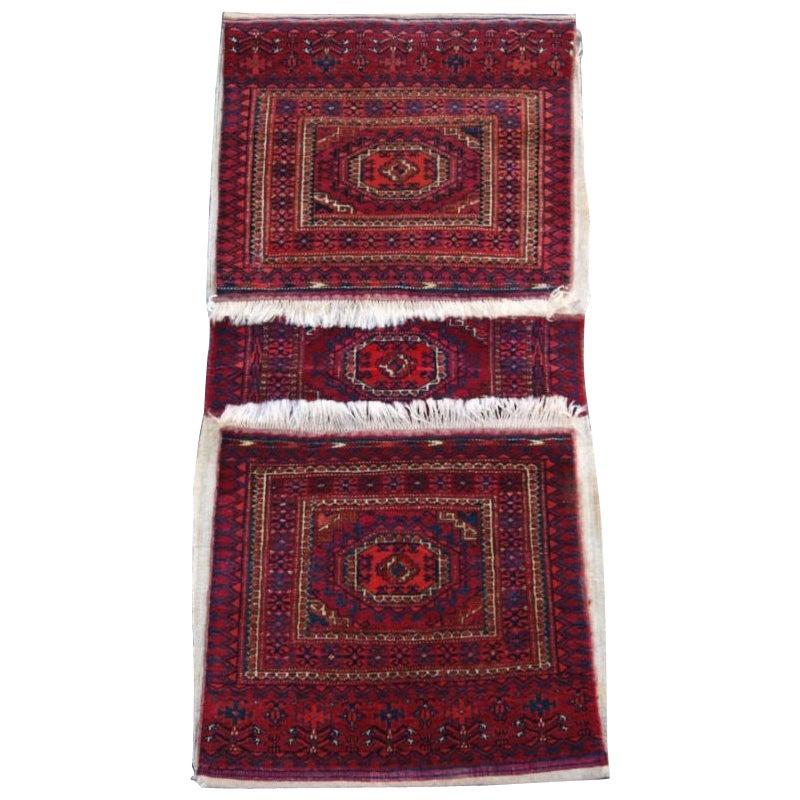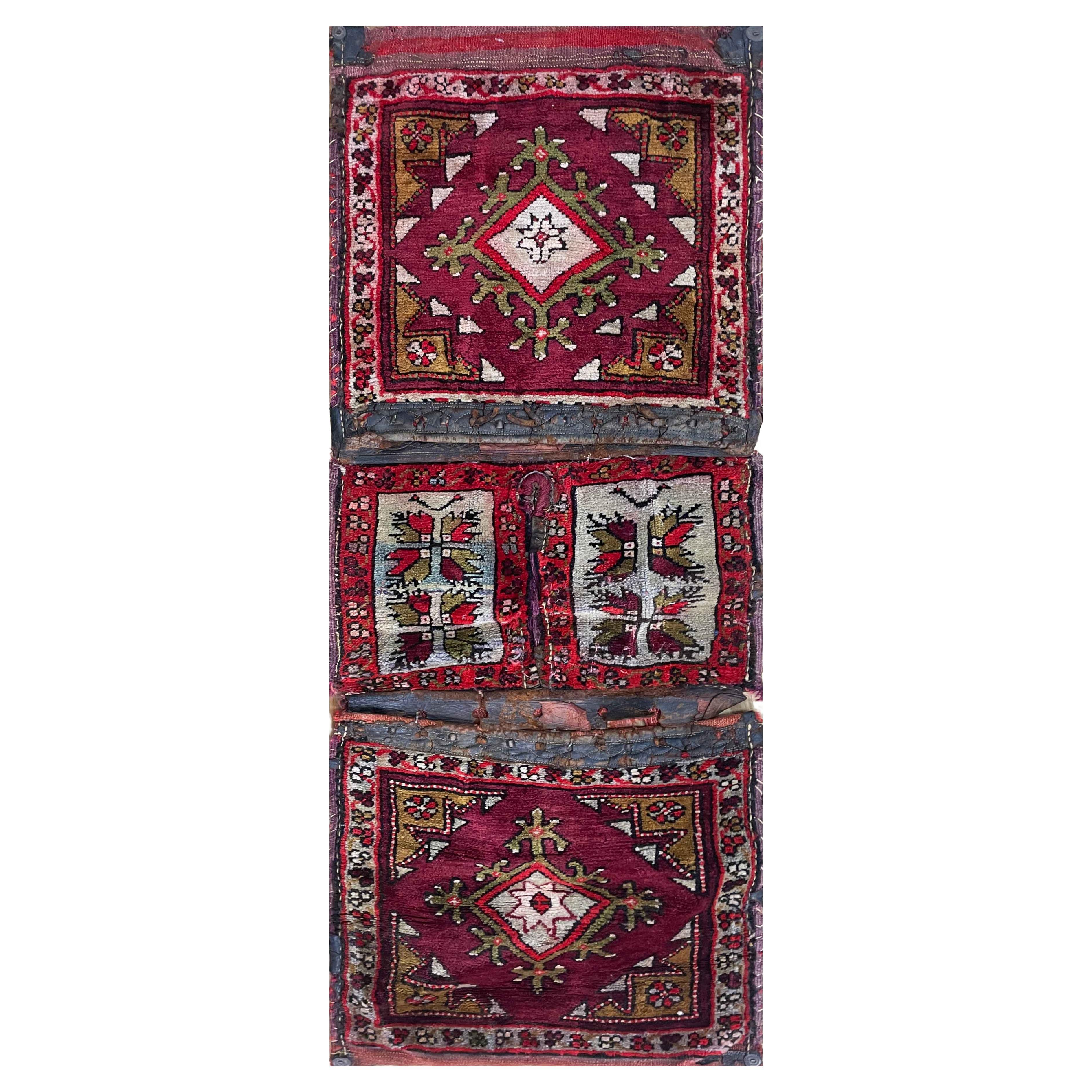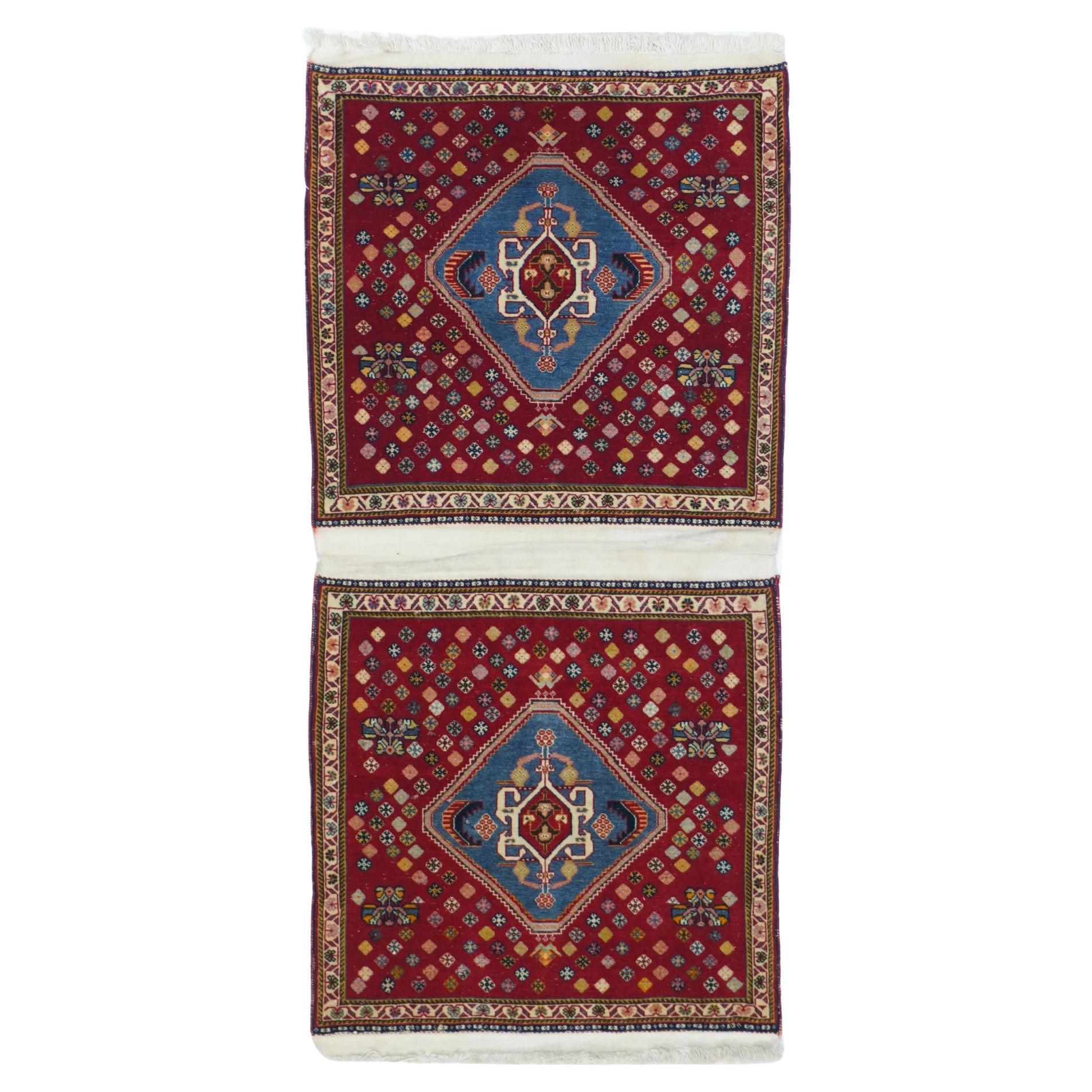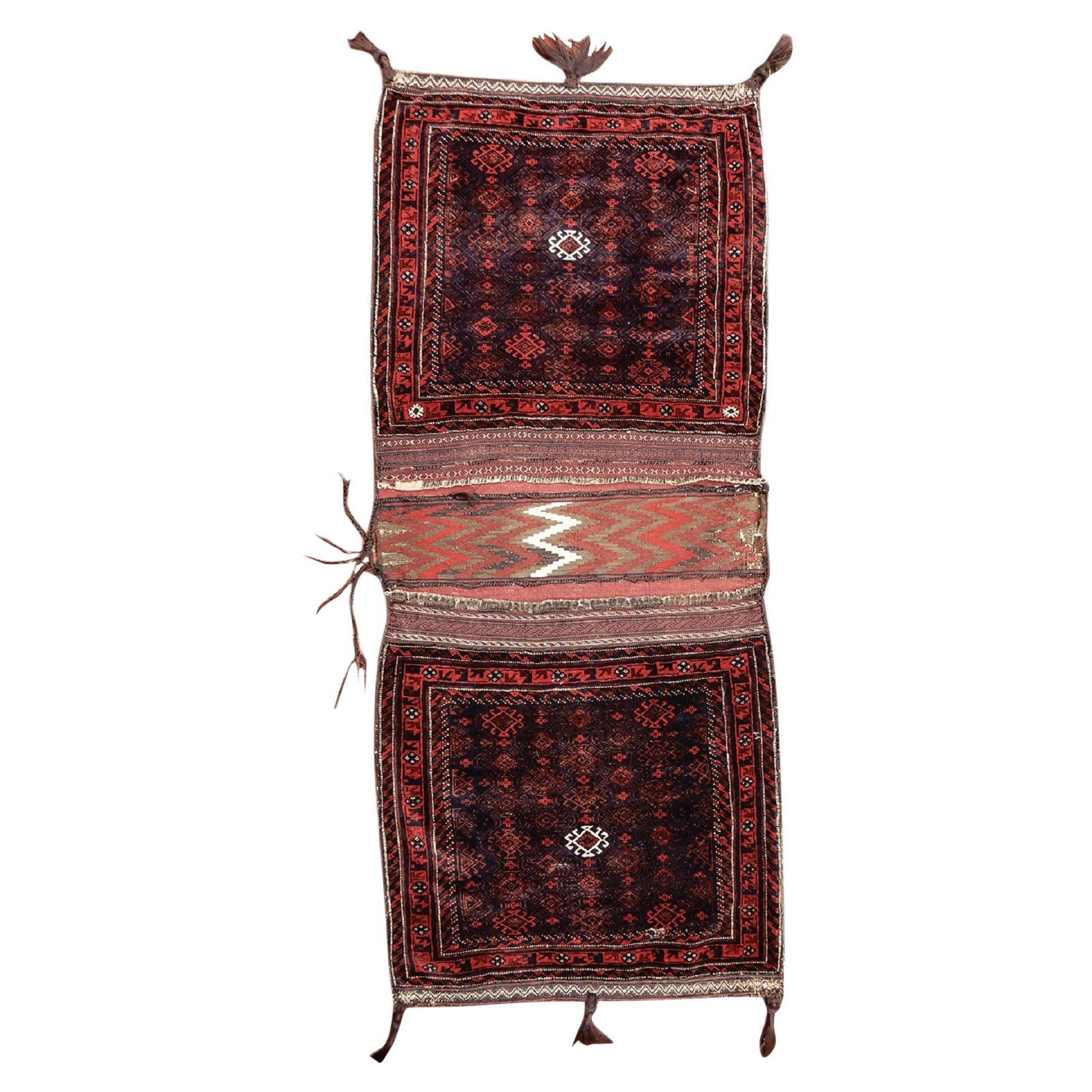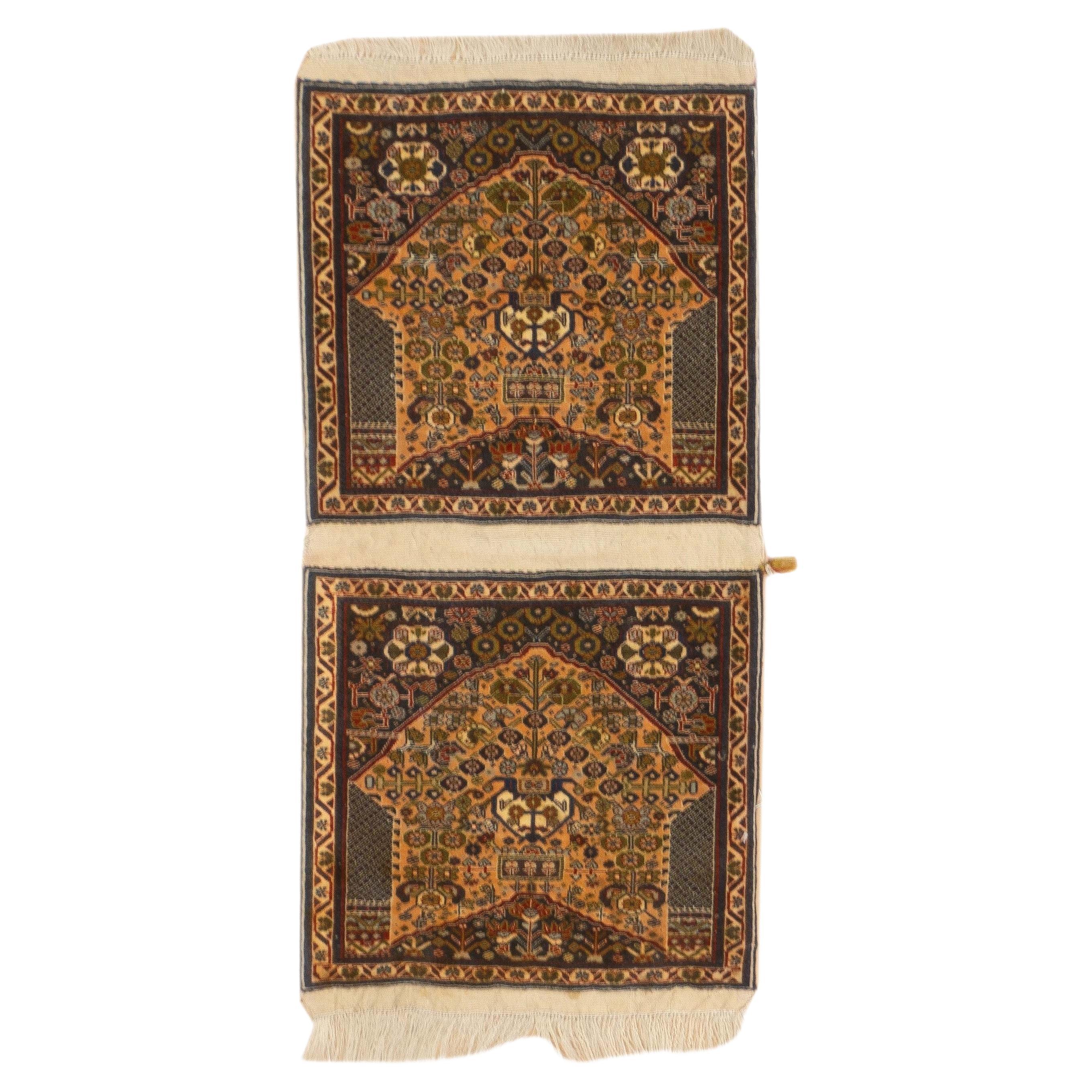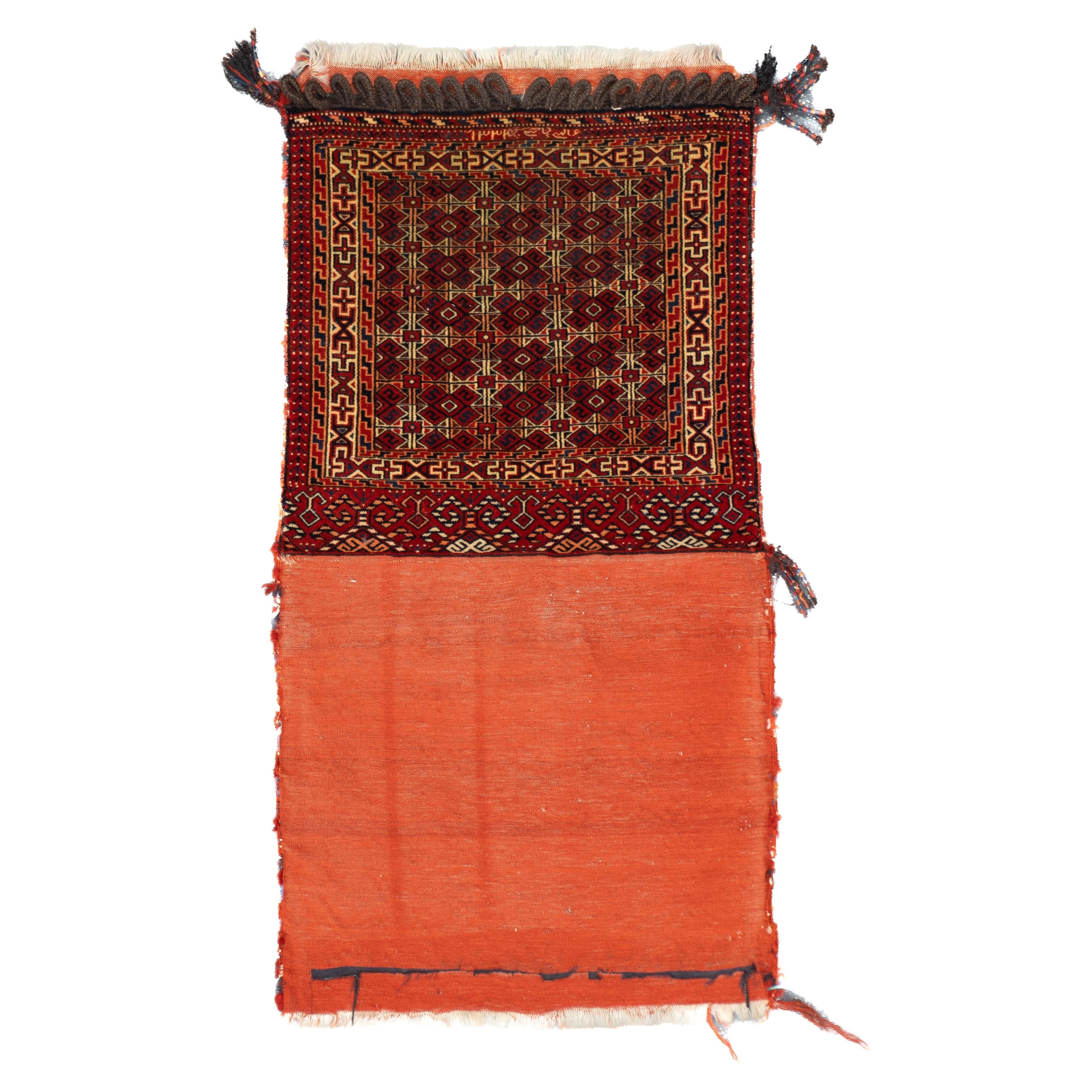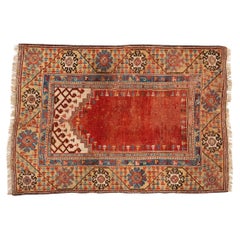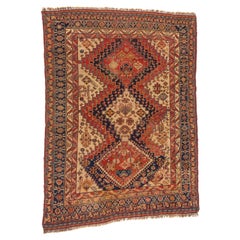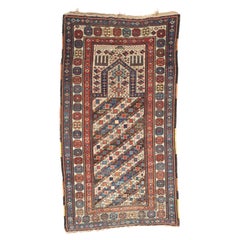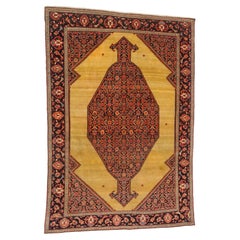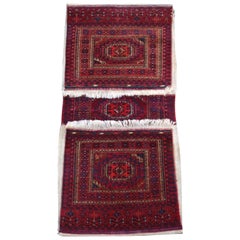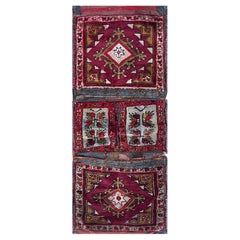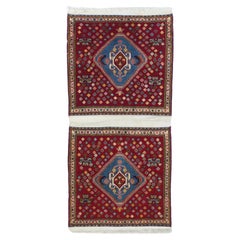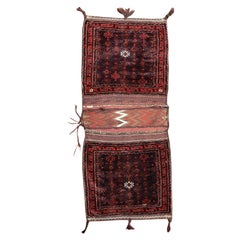Items Similar to Large Antique Turkomen Saddle Bags (Pair)
Want more images or videos?
Request additional images or videos from the seller
1 of 15
Large Antique Turkomen Saddle Bags (Pair)
$3,000
£2,276.33
€2,602.78
CA$4,190.19
A$4,658.92
CHF 2,432.63
MX$56,710.37
NOK 31,039.29
SEK 29,082.33
DKK 19,425.03
Shipping
Retrieving quote...The 1stDibs Promise:
Authenticity Guarantee,
Money-Back Guarantee,
24-Hour Cancellation
About the Item
These hard-to-find large saddle bags, which were used by Salor Turkomen nomadic tribes can serve as stuffed and comfortable cushions, to form a bottom and back unit, or are entirely sturdy enough to be used as rugs. The back of each is in a heavy canvas material. These are authentic tribal artefacts and the detailed pattern language reveals an increasingly rare item from the last quarter 19th century.
- Dimensions:Width: 70.08 in (178 cm)Length: 40.16 in (102 cm)
- Materials and Techniques:Wool,Hand-Woven
- Place of Origin:
- Period:
- Date of Manufacture:1880-1890
- Condition:Wear consistent with age and use.
- Seller Location:WYNNUM, AU
- Reference Number:1stDibs: LU7409239634732
About the Seller
No Reviews Yet
Vetted Professional Seller
Every seller passes strict standards for authenticity and reliability
1stDibs seller since 2022
- ShippingRetrieving quote...Shipping from: WYNNUM, Australia
- Return Policy
Authenticity Guarantee
In the unlikely event there’s an issue with an item’s authenticity, contact us within 1 year for a full refund. DetailsMoney-Back Guarantee
If your item is not as described, is damaged in transit, or does not arrive, contact us within 7 days for a full refund. Details24-Hour Cancellation
You have a 24-hour grace period in which to reconsider your purchase, with no questions asked.Vetted Professional Sellers
Our world-class sellers must adhere to strict standards for service and quality, maintaining the integrity of our listings.Price-Match Guarantee
If you find that a seller listed the same item for a lower price elsewhere, we’ll match it.Trusted Global Delivery
Our best-in-class carrier network provides specialized shipping options worldwide, including custom delivery.More From This Seller
View AllAntique Melas Turkish Prayer Rug
Located in WYNNUM, QLD
This is admittedly a collector’s piece, for a connoisseur. Melas rugs became known and appreciated in Europe as early as 1700, though its history of weaving goes back at least severa...
Category
Antique Early 19th Century Turkish Turkish Rugs
Materials
Wool
Unusually Fine Qashgai'i 1870 Antique Tribal rug short term reduction
Located in WYNNUM, QLD
Qashgai circa 1870-80
Qashgai, UNUSUALLY FINE ANTIQUE TRIBAL PIECE circa 1870 - 1880
3 x 5 ft
Acquired from a French dealer
The Qashgai Federation...
Category
Antique 1870s Persian Persian Rugs
Materials
Wool
Antique Long Gendje Caucasian Prayer Rug
Located in WYNNUM, QLD
An unusually long prayer rug – and comparatively rare Gendje – in good condition. Above average centre field variation of colour and a particularly lively top Mihrab area to place in...
Category
Antique 1880s Caucasian Caucasian Rugs
Materials
Wool
High Collectible 19th Century Ferahan Sarouk, Princely, at Short Term Reduction
Located in WYNNUM, QLD
Ferahan Sarouk Museum Quality
MUSEUM QUALITY Ferahan Sarouk, third quarter 19th century
6.6 x 4.5 feet
From a USA collector
Ferahan Sarouk carpets produced around the wider Arak (formerly Sultanabad) area from about 1850-1910 earned a deserved reputation as amongst the most desirable and imaginative finely woven carpets in Persia. As these things go, they morphed in style around 1910- 1920 into the differently woven Mahajirhan Sarouk fashion (quality examples of which are also in demand) and then disappeared entirely.
Their desirability rests not only on fine weaving, and excellent wool. Many of the better examples were commissioned by aristocrats or wealthy merchants who encouraged creativity, in an actively competitive way; rugs during this period, as before, were direct illustrations of an individual’s wealth, power and prestige.
Beyond this lay a more fundamental and seemingly contradictory set of motivations by the weavers. At one and the same time they sought to emulate the great court carpets in finesse and design. And yet-- they applied rustic or village, and even tribal elements and nuances to their designs. The result was a cavalcade of creativity.
So, a village-based genre came into being which produced primarily an approx. 6x4 rug size format, and also provided, if more rarely, larger formats, which command increasingly high prices, due to their rarity, visual excitement and grandeur.
The artistic achievement of this “school” had to do with marrying elegance and a degree of formalism with whimsy, and design innovation. They offer a charm and a certain magic beyond that of court and most city carpets.
As in any area or era, there is a quality spectrum ranging from mediocre to highly superior. Superiority is judged of course as to weave and wool quality. It is rather unusual, though, to encounter pieces made before 1890 -which are bona fide Ferahan Sarouks- with poor wool or weaving: standards were upheld during this period, and natural dyes were widely employed, particularly in the wider Arak (then Sultanabad) region.
Thus, as an investment collectible to adorn the home we believe the ultimate criterion is aesthetics, this being an art form, after all.
Ferahan Sarouks have been a special area of interest for us over the decades both from artistic and investment perspectives.
Allowing for personal taste, our suggestions are few and simple. A Ferahan Sarouk ought to display a wide colour palette, fine drawing and delicate, sometimes “intense “ detail. The finest pieces also display an elevated sense of balance in the use of space.
We have seen many finely woven pieces which in our view are garish and lack one of the two key artistic elements intrinsic to the better examples of this genre – elegance. Sometimes they are overly cluttered; the drawing artistry is muddled or lost. In other cases odd and ineffective design devices are used, detracting from or interfering with an otherwise good design. The era of the Ferahan Sarouk was rife with experiments, not all of them successful.
The other important attribute, when it can be found, is original artistic creativity, even serendipity, -- or effective design innovation within the compass of this rug type and the unique standards of its prime period.
On average, we examine between 30-40 antique Ferahan Sarouks to achieve one acquisition, for the benefit of our clients.
This highly collectible more than 150-year-old carpet is an apex achievement of superior artistry and innovation. As an exemplar of its genre, it can be reasonably described as Museum quality, a term we do not often employ.
Please observe the stunning precision of the inner guard and its pinpoint sharp hooks. The elongation of the central medallion is one of its subtle but powerful innovations in form. The nod to asymmetry – which displays a refined sense of humour - is seen in the use of the small diamond figures, as one is deliberately missing from the right hand side: a wry nod to asymmetry, in an otherwise perfectly symmetrical creation.
The ultimate achievement here is in the fineness of the weaving itself, on close inspection. The herati pattern in the medallion and corners achieves an etched-on quality, a very uncommon level of attention to detail and perfectionism: clearly the work of a master. This artistic sense extends to the outer ground which is a superb example of the most subtle abrash, one of the most refined we have had the honor of viewing. The unusual beige/brown tones in the field were probably achieved by adding onion skins to the die vat. These extremely fine gradations of colour are rarely seen.(NB the colour photographs create a slightly misleading- overly yellow burnish to the field colour in spite of expert photographic efforts ) .
The deliberate choice of an ink black use of indigo provides a powerful frame (border) for this piece of art, which note in the lower right-hand corner is lifted slightly through abrash to a deep blue – to highlight the design and use of emerald green in the rosettes. The green shades lighten as the border ascends harmonizing with the tones in the central medallion.
The floating flow of flowers in the border is beautifully executed, with up to seven colours in a single figure.
No doubt a piece commissioned by an aristocrat around 1870, it is – remarkably- in virtually perfect condition. It appears to have had very minimal footwear, and great care; a piece which was proudly displayed from time to time and appreciated. Its density and strong foundation would however allow regular use within a home, and in a spacious contemporary home or office could make a wall hanging of striking impact.
This remarkable one of a kind piece is on short term reduction to coincide with our launch on 1st Dibs . Fair market value is approximately $22,000 .
Fine art as investment ? The WSJ made the following comments this year :
The vigor of the art market may seem counterintuitive, but it makes sense in the current environment,” economist Tyler Cowen recently wrote in The Washington Post. “First, many of the wealthy have been buying additional homes and wish to furnish them with art. Second, the recent run-up in inflation rates around the world has intensified the search for hedges.”
While the aforementioned artworks fall into traditional categories, some less-prominent forms of fine art also represent ideal investment opportunities, especially because they offer more attractive—i.e., significantly less costly—entry points for new collectors. Take high-collectible and connoisseur-caliber antique Oriental rugs, for example. The best 19th-century examples often sell privately between five figures and low six figures.
Today, that obscurity is fading. According to Ben Evans, the editor of Hali Magazine—a publication dedicated to the international rug and textile market—there are two primary factors to explain why antique rugs are beginning to enjoy their moment in the spotlight. “Cultural curiosity and collecting...
Category
Antique 1880s Persian Persian Rugs
Materials
Wool
Antique Bidjar Long Rectangle
Located in WYNNUM, QLD
Bidjars are known as the "iron "carpets of Asia, owing to the hammering of knots whilst weaving, which creates an unusual density to the carpet, and exceptional , multi generational...
Category
Antique 1880s Persian Persian Rugs
Materials
Wool
Ersari Turkomen Very Rare small main carpet circa 1860 short term reduction
Located in WYNNUM, QLD
Acquired from a Viennese collector’s estate
The Ersari tribe of the wider Turkomen nation living in Turkmenistan, Afghanistan and Iran are one of the weaving tribes better known and understood by scholars. The Tekke Turkomen’s woven materials are perhaps best known in the West, followed by the Yomud, Salor and Ersaris. A Salor main carpet, 30% larger and about 40 years older than this piece recently sold in Austria for over $50,000, such is the scholarly , collection, and investment zeal found around the world . We are making this piece available at a short term steep discount to conincide with out launch on 1st Dibs .
These and other kindred tribes produce rugs, bags, Amalysks (bridal bags) and Engsis (Tent doors...
Category
Antique 1860s Turkestan Central Asian Rugs
Materials
Wool
You May Also Like
Antique Tekke Turkmen Saddle Bag
Located in Moreton-In-Marsh, GB
Antique Tekke Turkmen saddle bag (Khorjin) with Salor turreted gul design.
The bags are finely woven and have been opened down the sides for display. No...
Category
Antique 19th Century Turkmen Central Asian Rugs
Materials
Wool
Antique Turkish Anatolian Saddle Bag, Possible Eighteen century
Located in Evanston, IL
Antique Turkish Saddle bag made of flat weave or kilim.
In the past used for transportation on camels.
It's a collector rug or a very nice decorati...
Category
Antique 18th Century Persian Kilim Turkish Rugs
Materials
Wool
Extremely fine pair of saddle bag Persian Kashkouli Rug 2'0" x 4'0"
Located in New York, NY
Extremely fine pair of saddle bag Persian Kashkouli Rug 2'0" x 4'0".
Category
Vintage 1940s Persian Persian Rugs
Materials
Wool
Antique Persian Baluch Khorjin Saddle Bag, 19th Century
Located in San Francisco, CA
Antique Persian Baluch Khorjin Rug Saddle Bag, 19th Century (4th Quarter)
This exceptionally fine Baluch double saddle bag set, or ‘khorjin,’ was woven in...
Category
Antique 19th Century Persian Persian Rugs
Materials
Wool
Extremely Fine Double Saddle Bag attached Persian Qashqai 1'3'' x 2'8''
Located in New York, NY
Extremely Fine Double Saddle Bag attached Persian Qashqai 1'3'' x 2'8''. The best SW Persian, Fars Province nomadic rugs, mostly in scatter formats. Geometric Gabbehs, lion rugs, ada...
Category
Early 20th Century Persian Persian Rugs
Materials
Wool
Antique Persian Turkmen Saddle Bag (One of pair) 2'2'' x 3'4''
Located in New York, NY
Antique Persian Turkmen Saddle Bag (One of pair) 2'2'' x 3'4''. The rugs of the Central Asian/NW Persian/Afghanistan Turkic nomadic tribes employing guls (small medallions), wool from their own flocks, primarily red fields, and coarse to very fine knotting, in a wide variety of carpets, door rugs...
Category
Early 20th Century Persian Persian Rugs
Materials
Wool, Cotton
More Ways To Browse
Patterned Bags
19th Century Antique Saddles
Saddle Bags
Triangle Tables
Twisted Cocktail Table
Vintage Porcelain Roses
Antique Drop Side Tables
Belgium Tapestry
Blue Glass Tray
British Antique China
Carving Sets
Chartreuse Furniture
Crossed Base Dining Table
Dining Chairs From Portugal
Dragon Handle
Fantastic Antique Silver
France And Son Denmark
Mid Century Bar Cart Wheels
